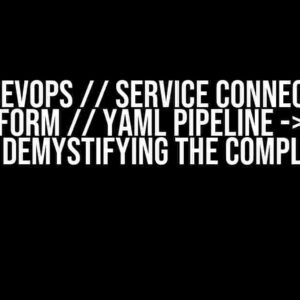If you’re using Azure DevOps and DotNetCoreCLI@2 to run tests for your .NET Core project, you’re on the right track! However, setting up the arguments for the test task can be a bit tricky. In this article, we’ll take a closer look at how to configure the arguments for the Azure Devops DotNetCoreCLI@2 test task and make the most out of your testing experience.
- The Importance of Arguments in Azure Devops DotNetCoreCLI@2 Test Task
- Understanding the Azure Devops DotNetCoreCLI@2 Test Task Structure
- Setting up the Arguments for the Azure Devops DotNetCoreCLI@2 Test Task
- Best Practices for Setting up Arguments in Azure Devops DotNetCoreCLI@2 Test Task
- Conclusion
The Importance of Arguments in Azure Devops DotNetCoreCLI@2 Test Task
Before we dive into the setup process, let’s quickly discuss why arguments are crucial in the Azure Devops DotNetCoreCLI@2 test task. The arguments determine how the test task behaves and what actions it performs. They can be used to specify the test framework, the test files, and even the environment variables. By setting up the arguments correctly, you can ensure that your tests run smoothly and efficiently, and that you get the most accurate results.
Understanding the Azure Devops DotNetCoreCLI@2 Test Task Structure
Before we start setting up the arguments, it’s essential to understand the structure of the Azure Devops DotNetCoreCLI@2 test task. The task consists of several sections, including:
- Task name and description
- Display name and description
- Inputs
- Arguments
- Environment variables
- Outputs
In this article, we’ll focus on the “Arguments” section, as it’s where you’ll specify the commands and options for the test task.
Setting up the Arguments for the Azure Devops DotNetCoreCLI@2 Test Task
Now that we’ve covered the basics, let’s move on to setting up the arguments for the test task. To access the arguments section, follow these steps:
- Open your Azure DevOps pipeline and navigate to the “Tasks” tab.
- Find the “DotNetCoreCLI@2” task and click on the three dots at the right end of the task.
- Click on the “Edit” option to open the task settings.
- Scroll down to the “Arguments” section.
In the “Arguments” section, you’ll see a text box where you can specify the commands and options for the test task. The syntax for the arguments is as follows:
dotnet [command] [options]Let’s break down the different parts of the syntax:
dotnet: This is the dotnet command-line interface (CLI) that executes the tests.[command]: This specifies the command to run, such astestorvstest.[options]: These are the options that customize the behavior of the command, such as specifying the test framework or the test files.
Here’s an example of a basic argument syntax:
dotnet test --logger trx --framework netcoreapp3.1In this example, the dotnet test command runs the tests using the trx logger and targets the netcoreapp3.1 framework.
Common Arguments for the Azure Devops DotNetCoreCLI@2 Test Task
Here are some common arguments you can use with the Azure Devops DotNetCoreCLI@2 test task:
| Argument | Description |
|---|---|
--logger |
Specifies the logger to use for the test output. Common values include trx, junit, and console. |
--framework |
Specifies the target framework for the tests. Common values include netcoreapp3.1, net5.0, and net6.0. |
--test-framework |
Specifies the test framework to use. Common values include nunit, xunit, and mstest. |
--test-framework-version |
Specifies the version of the test framework to use. |
--results-directory |
Specifies the directory where the test results will be stored. |
These are just a few examples of the many arguments you can use with the Azure Devops DotNetCoreCLI@2 test task. By combining these arguments, you can customize the test task to fit your specific needs.
Best Practices for Setting up Arguments in Azure Devops DotNetCoreCLI@2 Test Task
To get the most out of your test task, follow these best practices for setting up arguments:
- Use meaningful names for your tasks and arguments: This makes it easier to understand what each task and argument does, and helps you troubleshoot issues more efficiently.
- Keep your arguments organized: Use line breaks and whitespace to separate your arguments and make them easier to read.
- Test your arguments: Before running your pipeline, test your arguments to ensure they work as expected.
- Document your arguments: Document your arguments and their purpose, so that others can understand how your pipeline works.
By following these best practices, you can ensure that your test task is well-organized, easy to maintain, and produces accurate results.
Conclusion
In this article, we’ve covered the importance of arguments in the Azure Devops DotNetCoreCLI@2 test task, the structure of the task, and how to set up the arguments. We’ve also discussed common arguments and best practices for setting up arguments. By following the instructions and guidelines in this article, you can configure your test task to run smoothly and efficiently, and get the most accurate results for your .NET Core project.
Remember, the key to success lies in understanding how to set up the arguments correctly and using the right combination of options to customize the behavior of the test task. With practice and patience, you’ll become a pro at setting up arguments for your Azure Devops DotNetCoreCLI@2 test task!
Frequently Asked Question
Get ready to test your .NET Core projects with Azure DevOps! One of the most critical tasks is setting up the DotNetCoreCLI@2 test task. But, how do you set up those pesky arguments?
What is the purpose of the DotNetCoreCLI@2 test task in Azure DevOps?
The DotNetCoreCLI@2 test task is used to run .NET Core tests in Azure DevOps pipelines. It provides a way to execute tests, such as unit tests, integration tests, and functional tests, to ensure your .NET Core project is working as expected.
What are the required arguments for the DotNetCoreCLI@2 test task?
The required arguments for the DotNetCoreCLI@2 test task are the command (`test`), the project or solution file (`projects` or `solutions`), and the test configuration (`configuration`). You can also specify additional arguments, such as the test framework and the results file.
How do I specify the test project or solution file in the DotNetCoreCLI@2 test task?
You can specify the test project or solution file using the `projects` or `solutions` argument. For example, `projects: ‘**/*Tests.csproj’` or `solutions: ‘**/*.sln’`. You can also use wildcards to specify multiple projects or solutions.
Can I customize the test run settings in the DotNetCoreCLI@2 test task?
Yes, you can customize the test run settings by specifying additional arguments, such as the test framework, the results file, and the test timeout. For example, `arguments: ‘-framework netcoreapp3.1 -results-file:$(System.DefaultWorkingDirectory)/**/TestResults.trx’`.
How do I troubleshoot issues with the DotNetCoreCLI@2 test task in Azure DevOps?
To troubleshoot issues, check the task logs for errors and warnings. You can also enable debug logging by adding the `–verbose` argument to the task. Additionally, verify that the test project or solution file is correct, and the test configuration is set up correctly.



